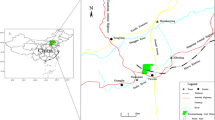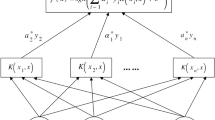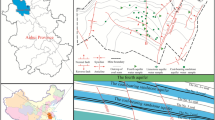Abstract
Previously proposed discriminant methods cannot accurately identify water sources in a complex multiaquifer mine. Based on statistical analysis of the water chemistry of samples collected at the Xinji no. 2 multiaquifer coal mine, a comprehensive stepwise discriminant method was proposed for this purpose. Characteristic ion contrast and ion proportional coefficients were applied to aquifers with distinct chemical characteristics to establish a characteristic index discrimination system. Aquifers with small differences in water chemistry were identified by the Fisher discriminant method. Different methods (first simple ones, followed by more complex ones) were used to distinguish the water sources of different aquifers. This approach enabled us to identify water sources for the Xinji no. 2 mine and should be tried for other sites with similar hydrogeological conditions.
Zusammenfassung
Bisher vorgeschlagene Diskriminanzmethoden können in komplexen, mehrere Grundwasserleiter betreffenden Bergwerken keine akkurate Identifizierung von Wasserquellen liefern. Basierend auf der statistischen Analyse des Chemismus von Wasserproben, die im Multi-Aquifer-Bergwerk Xinji Nr. 2 gesammelt wurden, wurde eine umfassende, schrittweise Diskriminanzmethode für diesen Zweck vorgeschlagen. Charakteristischer Ionen-Kontrast und Ionen-Anteil-Koeffizienten wurden für Grundwasserleiter mit bestimmten chemischen Charakteristika benutzt, um ein Unterscheidungssystem mit charakteristischen Indizes zu erstellen. Grundwasserleiter mit kleinen Unterschieden im Wasserchemismus wurden mit der Fischer-Diskriminanten-Methode unterschieden. Unterschiedliche Methoden (zunächst einfache, gefolgt von komplexeren) wurden benutzt, um Wasserquellen unterschiedlicher Grundwasserleiter zu unterscheiden. Dieser Ansatz erlaubte, die Quellen des Wassers im Bergwerk Xinji Nr. 2 zu identifizieren und sollten für andere Bergwerke mit ähnlichen hydrogeologischen Bedingungen getestet werden.
Resumen
Los métodos discriminantes propuestos anteriormente no pueden identificar con precisión las fuentes de agua en una mina compleja con varios acuíferos. Basándose en el análisis estadístico de la química del agua de las muestras recogidas en el Xinji N°2 de la mina de carbón multiacuífera, se propuso un método discriminante exhaustivo por etapas para este propósito. Se aplicaron los coeficientes de contraste iónico característico y proporcional a los iones a los acuíferos con características químicas distintas para establecer un sistema de discriminación de índice característico. Los acuíferos con pequeñas diferencias en la química del agua se identificaron mediante el método discriminante de Fisher. Se utilizaron diferentes métodos (primero los simples seguidos de otros más complejos) para distinguir las fuentes de agua de los diferentes acuíferos. Este enfoque permitió identificar las fuentes de agua para el Xinji N°2 y debe probarse para otros sitios con condiciones hidrogeológicas similares.
综合逐步判别法识别矿井含水层组水源
以往水源判别法不能准确识别复杂含水层条件矿井水源。基于新集二矿含水层组水化学成分统计, 提出了综合逐步判别法。对于水化学特征明显的含水层, 用特征离子对比和离子比例系数建立判别特征指数。对于水化学特征差异较小的含水层, 用Fisher判别法进行区分。采用不同方法(先简单, 再复杂)区分不同含水层水源。这套方法使我们能够识别新集二矿水源, 也可尝试用于其它水文地质条件相似矿井。











Similar content being viewed by others
References
Armengol S, Manzano M, Bea SA, Martinez S (2017) Identifying and quantifying geochemical and mixing processes in the Matanza-Riachuelo aquifer system, Argentina. Sci Total Environ 599:1417–1432
Chen HJ, Li XB, Liu AH (2009) Studies of water source determination method of mine water inrush based on Bayes’ multi-group stepwise discriminant analysis theory. Rock Soil Mech 30(12):3655–3670 (in Chinese)
Chen HJ, Li XB, Liu AH, Dong LJ, Liu ZX (2009) Forecast method of water inrush quantity from coal floor based on distance discriminant analysis theory. J China Coal Soc 34(4):487–491 (in Chinese)
Chen HJ, Li XB, Liu AH, Peng SQ (2009) Identifying of mine water inrush sources by Fisher discriminant analysis method. J Cent South Univ 40(4):1114–1120 (in Chinese)
Chen LW, Yin XX, Gui HR (2013) Water-rock interaction tracing and analysis of deep quifers in the mining area using isotope and hydrochemistry methods. Acta Geol Sin 87(7):1021–1030 (in Chinese)
Chidambaram S, Anandhan P, Prasanna MV, Srinivasamoorthy K, Vasanthavigar M (2013) Major ion chemistry and identification of hydrogeochemical processes controlling groundwater in and around Neyveli lignite mines, Tamil Nadu, South India. Arab J Geosci 6(9):3451–3467
Cloutier V, Lefebvre R, Therrien R, Savard MM (2008) Multivariate statistical analysis of geochemical data as indicative of the hydrogeochemical evolution of groundwater in a sedimentary rock aquifer system. J Hydrol 353(3–4):294–313
Deutsch WJ (1997) Groundwater geochemistry fundamentals and applications to contamination. CRC Press, New Jersey, pp 61–67
Fu XJ, Lai DJ, Wang XM, He QL (2004) Brief comments on water inflow mechanism of coal mining facetested under water body. Coal Sci Technol 32(4):69–71 (in Chinese)
Gong FQ, Lu JT (2014) Recognition method of mine water inrush sources based on the principal element analysis and distance discrimination analysis. J Min Safety Eng 31(2):236–242 (in Chinese)
Huang PH, Chen JS (2011) Fisher indentify and mixing model based on multivariate statistical analysis of mine water inrush sources. J China Coal Soc 36(S1):131–136 (in Chinese)
Huang PH, Wang XY (2018) Piper-PCA-Fisher recognition model of water inrush source: a case study of the Jiaozuo mining area. Geofluids 2018:1–10
Jia ZX, Zang HF, Zhen XQ (2015) The origin of Na+, Cl- and thermal source of karst groundwater in the stagnant area of Liulin spring basin. Carsol Sin 34(6):570–576 (in Chinese)
Jiang AN, Liang B (2006) The particle swarm optimization support vectors machine method of identifying standard components of ions of groundwater. J China Coal Soc 31(3):310–313 (in Chinese)
Jin LF, Zhang WB (2002) Nappe cambrain system geology and hydrological geology characteristic in Xinji mine area. Coal Techno 21(9):64–65 (in Chinese)
Ju QD, Hu YB, Zhang SY (2018) Mine water inrush source identification method based on principal component analysis and Bayesian discriminant. Coal Eng 50(12):90–94 (in Chinese)
Kumar M, Herbert R, Ramanathan A, Rao MS, Kim K, Deka JP, Kumar B (2013) Hydrogeochemical zonation for groundwater management in the area with diversified geological and land-use setup. Chem Erde-Geochem 73(3):267–274
Li X, Chen WF, Wang LQ, Xia FX, Zhang YB, Yuan ML (2017) An analysis of hydrochemical characteristics and environmental isotopic characteristics of the groundwater in the bedrock mountain area in Northern Songxian County, Henan Province. Acta Geosci Sin 38(3):403–412 (in Chinese)
Liu HH, Cao YQ (2011) Technologies of preventing coal mine Water hazards for sustainable development in north China. Geotech Geol Eng 29(1):1–5
Liu Q, Sun YJ, Xu ZM, Xu G (2018) Application of the comprehensive identification model in analyzing the source of water inrush. Arab J Geosci 11(9):1–10
Matter JM, Waber HN, Loew S, Matter A (2006) Recharge areas and geochemical evolution of groundwater in an alluvial aquifer system in the Sultanate of Oman. Hydrogeol J 14(1–2):203–224
Mondal NC, Singh VP, Singh VS, Saxena VK (2010) Determining the interaction between groundwater and saline water through groundwater major ions chemistry. J Hydrol 388(1–2):100–111
Petitta M, Mugnozza GS, Barbieri M, Fasani GB, Esposito C (2010) Hydrodynamic and isotopic investigations for evaluating the mechanisms and amount of groundwater seepage through a rockslide dam. Hydrol Process 24(24):3510–3520
Qian H, Ma ZY, Li PY (2005) Hydrogeochemistry. Geological Publishing House, Beijing, pp 45–50
Qiu M, Shi LQ, Teng C, Zhao Y (2017) Assessment of water inrush risk using the fuzzy delphi analytic hierarchy process and grey relational analysis in the Liangzhuang coal mine, China. Mine Water Environ 36(1):39–50
Salinas-Garcia JR, Hons FM, Matocha JE (1997) Soil carbon and nitrogen dynamics as affected by long-term tillage and nitrogen fertilization. Biol Fert Soils 25(2):182–188
Stumm W, Morgan JJ (1995) Aquatic chemistry, 3 Edit. Wiley, New York City, pp 398–416
Su CT, Nie FY, Zou SZ, Zhao GS, Luo F, Huang QB, Ba JJ, Li XP, Liang JP, Yang Y (2018) Hydrochemical characteristics and formation mechanism of strontium-rich groundwater in Xintian County, Hunan Province. Geoscience 32(3):554–564 (in Chinese)
Sun FX, Wei JC, Wang YP, Liu CE (2017) Recognition method of mine water source based on Fisher’s discriminant analysis and centroid distance evaluation. Coal Geol Explor 45(1):80–84 (in Chinese)
Wang XY, Ji HY, Wang Q, Liu XM, Huang D, Yao XP, Chen GS (2016) Divisions based on groundwater chemical characteristics and discrimination of water inrush sources in the Pingdingshan coalfield. Environ Earth Sci 75(10):1–11
Wang J, Li XB, Cui T, Yang JL (2011) Application of distance discriminant analysis method to headstream recognition of water-bursting source. Procedia Eng 26:374–381
Wang BB, Lu GP, Hu XN, Ou H (2019) Hydrochemical characterization of thermal spring waters in the deep fault region in western Guangdong. Environ Chem 38(5):1150–1160 (in Chinese)
Wang XY, Xu T, Huang D (2011) Application of distance discriminants in identifying water inrush resource in similar coalmine. J China Coal Soc 36(8):1354–1358 (in Chinese)
Wang Y, Zhou MR, Yan PC, He CY, Liu D (2017) Identification of coalmine water inrush source with PCA-BP model based on laser-induced fluorescence technology. Spectrosc Spect Anal 37(3):978–983
Wu W, Hu YB, Wang HZ (2012) Coal Seam’s characteristics of hydrogeology in Xinji No. 2 mine and calculation of water yield. Coal Technol 31(1):157–159 (in Chinese)
Xu ZM, Sun YJ, Gao S, Zhao XM, Duan RQ, Yao MH, Liu Q (2018) Groundwater source discrimination and proportion determination of mine inflow using ion analyses: a case study from the Longmen coal mine, Henan Province, China. Mine Water Environ 37(2):385–392
Xu ZJ, Yang YG, Tang L (2007) Application of BP neural network in evaluation of water source in mine. Saf Coal Mine 38(2):4–6 (in Chinese)
Yan ZG, Bai HB (2009) MMH Support vector machines model for recognizing multi-headstream of water inrush in mine. China J Rock Mech Eng 28(2):324–329 (in Chinese)
Yan BQ, Ren FH, Cai MF, Qiao C (2020) Bayesian model based on Markov chain Monte Carlo for identifyingmine water sources in submarine gold mining. J Clean Prod 253(1):1–10
Yang WF, Shen DY, Ji YB, Wang Y (2012) Discrimination of mine water bursting source based on fuzzy system. Appl Mech Mater 1810(365):644–648
Yang BB, Yuan JH, Duan LH (2018) Development of a system to assess vulnerability of flooding from water in karst aquifers induced by mining. Environ Earth Sci 77(3):1–13
Yin XX, Xu GQ, Gui HR, Chen LW (2006) Analyzing for sources of inrush-water in Wanbei mining area by systemic clustering and stepwise distinguishing. Coal Geol Explor 34(2):58–61 (in Chinese)
Yue M (2002) Related analysis of gray system applied to determinate water resources of mine water inrush. Coal Sci Technol 30(4):37–39 (in Chinese)
Zhang WB (2001) Features of lower horse strata and its significances for retain waterproof pillar in no. 2 coal mine of Xinji. Coal Geol China 13(3):40–41 (in Chinese)
Zhang M, Liu QM, Zhang YT (2018) Fisher discrimination model for sources of mine water inrush based on PCA analysis. Coal Technol 37(3):172–174 (in Chinese)
Zhou J, Shi XZ, Wang HY (2010) Water-bursting source determination of mine based on distance discriminant analysis model. J China Coal Soc 35(2):278–282 (in Chinese)
Acknowledgements
Our deepest gratitude goes to the editors and anonymous reviewers for their careful work and thoughtful suggestions that helped improve this paper substantially. The authors also gratefully acknowledge the financial support of the National Natural Science Foundation of China (41602310) and China Postdoctoral Science Foundation (2017M611044).
Author information
Authors and Affiliations
Corresponding author
Rights and permissions
About this article
Cite this article
Jiang, C., An, Y., Zheng, L. et al. Water Source Discrimination in a Multiaquifer Mine Using a Comprehensive Stepwise Discriminant Method. Mine Water Environ 40, 442–455 (2021). https://doi.org/10.1007/s10230-020-00742-2
Received:
Accepted:
Published:
Issue Date:
DOI: https://doi.org/10.1007/s10230-020-00742-2




